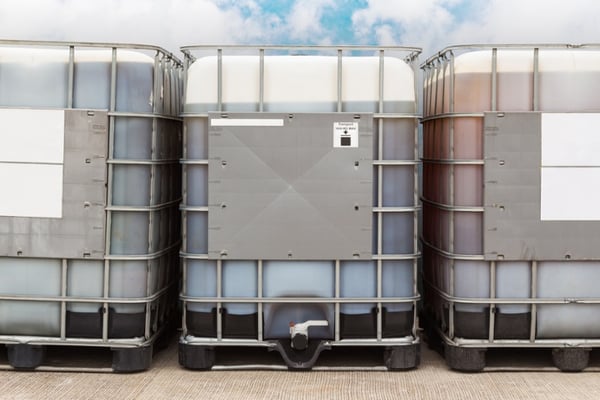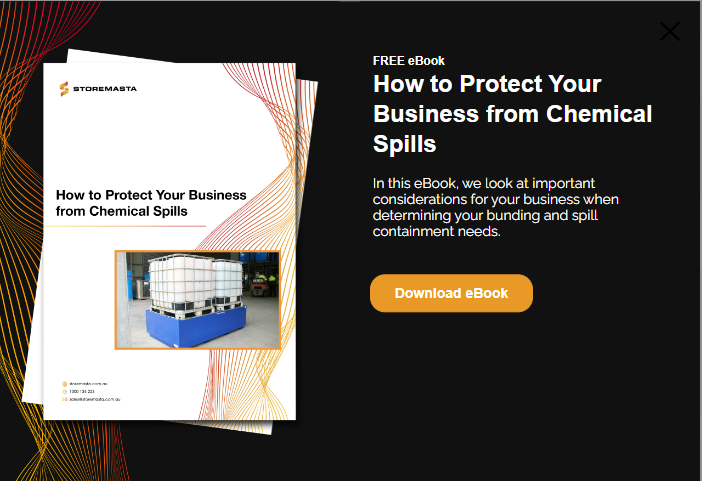Whether you call them tanks, bulkiboxes or pods, intermediate bulk containers (IBCs) are a common site in Australian workplaces. Commonly used to store large amounts of dangerous or hazardous substances, IBCs are sizeable bulk containers which are used across a vast range of industries. Due to the increased volumes that these containers hold, if IBCs are damaged or mishandled there is an even greater risk of hazard. So, if you are utilising IBCs onsite, it’s important to make sure that you have the appropriate spill containment measures in place. This will minimise the chance of workplace hazards occurring in the event of an IBC leak or spill. In this blog, we take a closer look at these containers and IBC bunding products, as well as the legal requirements for spill containment that may apply to your workplace.
What are Intermediate Bulk Containers?
Created by Olivier J. L. D’Hollander in the early 1990s, IBCs were created as an alternative to 200 litre drums. The rectangular design of the container allowed it to carry much larger volumes than the drums, while improving efficiency through easier storage and transportation.
Rigid IBCs
There are two types of IBCs – flexible and rigid. Flexible IBCs are cube-shaped bags that are fully collapsible when empty. This type of IBC is manufactured from polypropylene and is designed to transport dry or granulated products such as sand, mulch or fertiliser.
Rigid IBCs, however, can hold over 1000 litres and are the preferred storage product for bulk liquids and powders. As rigid IBCs are rectangular in shape and made from a durable high-density polyethylene, they provided a safer and more transportable storage solution for businesses. Caged IBCs feature a container that’s pallet-mounted and encased in a wire cage for extra protection. These rigid containers are commonly used to store flammable liquids, corrosive substances, toxic substances and other dangerous goods.

Rigid IBCs without storage pose a risk to people, property and environment
Applications
The IBC has been utilised across the world by a diverse range of industries including food and beverage manufacturing, petroleum production, construction, wastewater, farming, agriculture and more.
Spillage Risks
When a leak or spill does occur with an IBC, your spill bunding will protect against the uncontrolled flow of hazardous substances into your workplace. With the capacity of IBCs being greater than 1000 litres, your secondary containment plan must be compliant so you can prevent a serious hazard from occurring. Large volumes of hazardous or dangerous substances can harm your team, your property and the surrounding environment.
Risks May Include:
- Acute and chronic health hazards
- Damage to property including buildings, equipment and transport
- Risk of fire and explosion of flammable liquids
- Water pollution & soil contamination
Spill Containment Requirements for IBCs
To prevent or minimise the occurrence of hazardous chemical spills, WHS Regulations require Australian businesses to contain and manage spills.
The WHS Regulation explains that:
Subdivision 2 Spills and damage
357 Containing and managing spills
- A person conducting a business or undertaking at a workplace must ensure, so far as is reasonably practicable, that where there is a risk from a spill or leak of a hazardous chemical in a solid or liquid form, provision is made in each part of the workplace where the hazardous chemical is used, handled, generated or stored for a spill containment system that contains within the workplace any part of the hazardous chemical that spills or leaks, and any resulting effluent.
The required bund capacity for your hazardous substances will be determined by the dangerous goods classification of the chemicals that you are storing. Each class of dangerous goods has its own requirements for bund capacity, which are detailed in the appropriate Australian Standard.
For example, if you are storing flammable liquids, your required IBC bunding capacity as stated in AS 1940 – The storage and handling of flammable and combustible liquids would be:
Class 3 – Flammable Liquid
(d) The capacity of the spillage containment compound shall be at least 100% of the volume of the largest package plus 25% of the storage capacity up to 10 000 L, together with 10% of the storage capacity between 10 000 L and 100 000 L, and 5% above 100 000 L.
-1.jpg?width=600&height=401&name=New%20Bunding%20Edited%20(5%20of%2033)-1.jpg)
IBC Bunding is important for spill protection and compliance.
To calculate your spill containment requirements, you must consider that your bulk containers are four times larger than 205 litre drums. Therefore, these containers require a greater spill containment capacity — which is calculated on the volume of the largest IBC.
For example, a calculation for IBC flammable liquid storage is:
Spill capacity = 1 x volume of largest IBC + .25 x aggregate capacity (up to 10 000 L) + .1 x aggregate capacity (10 000 – 100 000 L) + .05 x aggregate capacity (100 000 L+)
If you’d like to learn more about spill bund capacity, visit our blog How Do You Calculate Spill Bund Capacity. This details the required bund capacities for each class of dangerous goods.
Selecting IBC Bunding
To meet the requirements for storage of your IBCs, there are a number of compliant IBC bunding products that are available.
Each has been specifically designed and manufactured to meet the stringent requirements as laid out in the Australian Standards for each dangerous goods class.
Some of our Australian-made, compliant bunding products include:
- Single IBC bunds
- Double IBC bunds
- Polyethylene IBC bunds (for corrosive chemicals)
- Steel IBC bunds (for flammable & combustible chemicals)
- Heavy duty steel IBC bunds (for flammable & combustible chemicals)
Features and add-ons also include:
- Chemical dispensing trays – for easy, spill-free decanting straight from your IBC
- Spill funnels – which act as both a debris strainer and a decanting aid
- IBC bund covers – to protect from rain and contaminants
IBC Bunds That Comply With Australian Standards
Our polyethylene IBC bunding products comply with Australian Standards:
- AS 2714 – The storage and handling of organic peroxides
- AS/NZS 4452 – The storage and handling of toxic substances
- AS 3780 – The storage and handling of corrosive substances
- AS 4326 - The storage and handling of oxidising agents
Steel IBC bunding products may comply with:
- AS 1940 – The storage and handling of flammable and combustible liquids
- AS 4326 - The storage and handling of oxidising agents
- AS 2714 – The storage and handling of organic peroxides
- AS/NZS 4452 – The storage and handling of toxic substances
- AS 3780 - The storage and handling of corrosive substances
Spill Bunding For IBC
If your organisation uses IBCs, you need to be able to effectively manage the risks associated with using and storing large volumes of hazardous substances. When choosing IBC bunding, it’s important to understand the chemical and physical properties of your chemicals as well as the dangerous goods category of your substances. But IBC bunding is just one part of your secondary containment plan. If you’re interested in finding out how to better manage the risks associated with workplace chemical spills and leaks, please download our FREE eBook and learn how to contain hazardous leaks and spills in your operations.

Living life by the 4 C’s of marketing – communication, coffee, compliance… and more coffee – Leisa Andersen is Storemasta’s Content Marketing Manager. When she’s not writing, you’ll find her enjoying all the good things in life, including shopping, travel and gluten free donuts.
